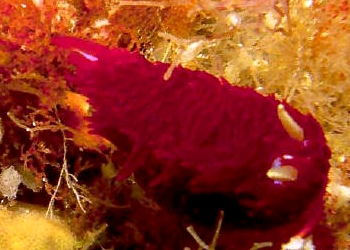
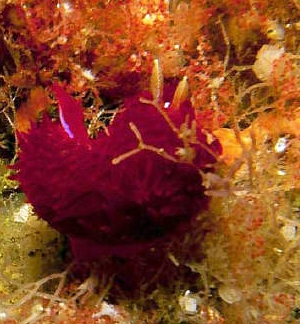
Janolus ignis
Miller & Willan, 1986
Order: NUDIBRANCHIA
Suborder: ARMININA
Family: Zephyrinidae
DISTRIBUTION
Throughout the main islands of New Zealand. Inhabits only clean water situations and is apparently confined to subtidal depths.
PHOTO
Blue Maomao Arch, Poor Knights Islands, NE New Zealand, May 2003. on the underside of a rock, close to the entrance to the archway. Approx 2-3cm long. Photos: Crispin Middleton
Upper part of body uniform, deep brick-orange, patterned with pale violet (or lilac-blue) streaks, the most prominent of which encircles rhinophores and forms a Y immediately behind them; streaks short on back, especially noticeable over pericardium; a continuous lilac-blue line encircles foot just below smallest cerata and extends onto tail but does not reach tip. Cerata deep orange-red, paler distally. Foot orange, lighter than notum or cerata. Oral tentacles orange, becoming creamish yellow at tips. Rhinophores creamish yellow, with narrow white streak along axis on posterior face.
Body & foot large (to 50 mm in length), elongate, broader anteriorly. Two large, thick oral tentacles present, one on either side of the mouth; oral tentacles slightly shorter than cerata in that region. Anus in midline, two-thirds of way down body. Pericardium in front of anus. Rhinophores tall, held erect, bearing 14 or 15 lamellae that alternate regularly towards pointed apices but become irregular proximally; lamellae present for entire length of rhinophores. Caruncle rather low, narrow, parallel-sided; consisting of a few crinkled lamellae, extending a short distance behind rhinophores. Cerata elongate, smooth, with pointed apices, digestive diverticulum undivided internally and not visible from the outside; largest cerata occur on middle section of body - approximately twice length of rhinophores, many shorter cerata present on sides of body below large one; densest cerata located on back and sides, cerata sparse (only 5 to 8) around anterior margin of head in advance of rhinophores
It is known only from the original description which included records from Stewart Island, Wellington, Poor Knights Islands and the Three Kings Islands, showing a wide distribution throughout New Zealand. It is reported to be active nocturnally, residing during the day within clumps of its food, the red arborescent bryozoan Orthoscuticella aff. margaritacea.
Reference:
• Miller, M.C. & Willan, R.C. (1986)A review of the New Zealand arminacean nudibranchs (Opisthobranchia: Arminacea). New Zealand Journal of Zoology 13: 377-408.
Rudman, W.B., 2003 (June 4) Janolus ignis Miller & Willan, 1986. [In] Sea Slug Forum. Australian Museum, Sydney. Available from http://www.seaslugforum.net/find/janoigni
Related messages
Re: Janolus ignis from New Zealand
May 7, 2009
From: Debbie Freeman
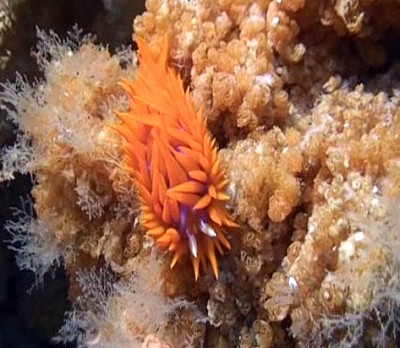
Concerning message #12960:
Hi,
I thought you might be interested in some photos of what appears to be Janolus ignis. It was observed at Molly Cap, Bounty Islands, New Zealand. The islands are about 600 km from mainland New Zealand, so it was certainly interesting to see what was around! Apologies for the poor quality of the photos - they were taken from video footage.
Locality: Molly Cap, Bounty Islands, 20 metres, New Zealand, Pacific Ocean, 16 March 2009, On bryozoan, vertical rocky reef.. Length: 40 mm. Photographer: Debbie Freeman.
Kind regards,
Debbie Freeman.
dfreeman@doc.govt.nz

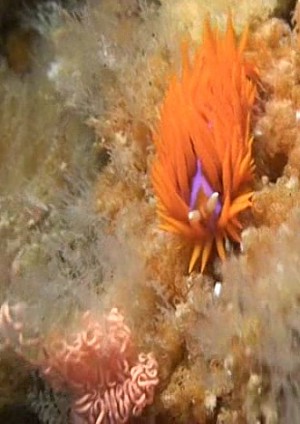

Dear Debbie,
This is an interesting find. You don't mention that the Bounty Islands are in the cold waters 600 k SE of southern New Zealand, which gives Janolus ignis a huge distribution from the warm northern waters of the Poor Knights Islands to far south of the South Island of NZ. If you have photos of any other opisthobranchs from the Bounty Islands they would be of great interest.
Interestingly the orange pigmentation in your animals is similar to the animals in an earlier message [#18129] from the South Island, suggesting there may be colour differences between northern and southern populations of the species. The deep red specimens have been reported to feed and live on the deep red arborescent bryozoan Orthoscuticella aff. margaritacea, which is present in some of the earlier messages. In your photos I can see a similar looking bryozoan with curled 'fronds' but it is orange not deep red. I suspect it is what we call Orthoscuticella ventricosa (Bush, 1852) in SE Australia.
Perhaps the colour difference is directly related to pigments in their bryozoan food - orange Janolus on orange bryozoans and red on red bryozoans. It would be an interesting research project.
The other nice thing in your photos is the pink coiled string in the middle right photo. I am pretty sure this is the egg string of Janolus.
Best wishes,
Bill Rudman
Janolus ignis from Kaikoura, New Zealand
October 26, 2006
From: Kimberley Seaward
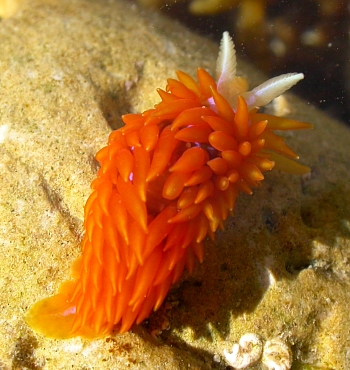
Concerning message #4159:
Hello,
I found this species of nudibranch in Kaikoura, New Zealand when conducting routine surveys of the intertidal for the University of Canterbury.
I had a assumed that it was relatively common and would at least be mentioned somewhere in Powell's New Zealand Mollusca or Morton and Miller's The New Zealand Sea Shore. However, the only mention of something similar that I stumbled across was of the water colour drawing of Aeolidia. Can you please help me identify this??
Locality: Beach, 0m out of water at low tide, New Zealand, Pacific Ocean, 8 October 2006, Intertidal on brown seaweed. Length: 10mm. Photographer: Kimberley Seaward.
Kimberley Seaward
kimberley.seaward@canterbury.ac.nz
Seaward, K.J., 2006 (Oct 26) Janolus ignis from Kaikoura, New Zealand . [Message in] Sea Slug Forum. Australian Museum, Sydney. Available from http://www.seaslugforum.net/find/18129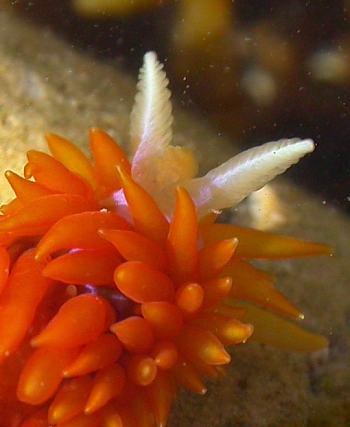
Dear Kimberley,
Your animal does look quite like an aeolid nudibranch, but it is not one. One external clue to its identity is the warty protuberance growing between the rhinophores. The function of this object is not clear, but it is found only in some genera of the arminoidean family Zephyrinidae. I am pretty sure your animal is Janolus ignis. Animals I have seen before of this species are a darker colour than this, but there are so few records of it that we really don't know the extent of its colour variability. Have a look at the species Fact Sheet for further information. The bluish white lines down the rhinophores and on the body are characteristic of this species, which is known from about half a dozen records throughout New Zealand. It wasn't named until some years after the two books you mentioned were published.
If you have other photos of New Zealand nudibranchs, even ones you have identified, they would be very welcome on the Forum.
Best wishes,
Bill Rudman
Janolus ignis from New Zealand
January 25, 2005
From: Ian Skipworth
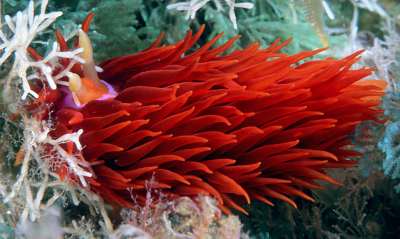
Hi Bill
This one's Janolus ignis I think, although it looks a little different from the pics on your fact sheet.
Locality: Poor Knights Islands, NE New Zealand.
Depth: 8m. Length: 45 mm.12 January 2005, Rocky reef
Photographer: Ian Skipworth
Cheers
Ian
ian@ianskipworth.com
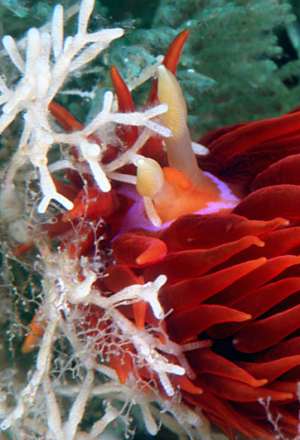
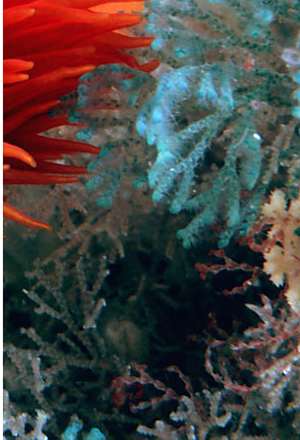
Dear Ian,
This is definitely Janolus ignis. The name ignis refers to its fiery appearance, and in your photo it certainly looks like a ball of flame. I have included a close-up to show the characteristic colour markings on the head, including the bluish Y shape around the rhinophores. I hae also included a close-up to show the arborescent bryozoans in which it is living. It feeds on the reddish Orthoscuticella aff. margaritacea. I am not sure if there are two species of bryozoan in your photo. Some branches are reddish and others are bluish. It may be two species are colour variation in one.
Best wishes,
Bill Rudman
Janolus ignis - eggs?
June 10, 2003
From: Crispin Middleton
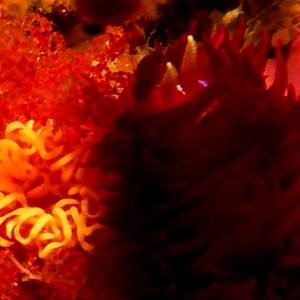
Hi Bill,
To accompany my earlier message here is another photo. It doesn't really show much new but I thought you could look anyway.
Thanks
Crispin
crispinm@ihug.co.nz
Middleton, C., 2003 (Jun 10) Janolus ignis - eggs?. [Message in] Sea Slug Forum. Australian Museum, Sydney. Available from http://www.seaslugforum.net/find/10188Dear Crispin,
I'm glad you sent this as I suspect the yellowish tangle to the left of the animal is its egg ribbon attached to its bryozoan food, Orthoscuticella aff. margaritacea. Miller & Willan (1986) describe the spawn as a mass of orange-red or salmon-pimk strings, loosely tangled at the apices of Orthoscuticella aff. margaritacea clumps.." I'm pretty sure this is the first time it has been illustrated.
Best wishes
Bill Rudman
Janolus ignis from New Zealand
June 5, 2003
From: Wade Doak & Crispin Middleton


Dear Bill,
Crispin Middleton has posted the following message and photos on my website www.wadedoak.com. It is from the Poor Knight's Islands in northern New Zealand and we can't identify it.
Wade Doak
wade@igrin.co.nz
"On a fantastic night dive last weekend at Blue Maomao arch [Poor Knights Islands, NE New Zealand, May 2003] I spotted these small red nudibranchs on the underside of a rock, close to the entrance to the archway. I haven’t seen them before or managed to identified them. They were blood red and only about 2-3cm long. Initially I thought they were some kind of anemone similar to waratah anemones, close inspection proved otherwise! The pictures are not as clear as I hoped, it was quite a squeeze under a rock to reach the little fellas!
Cheers
Crispin"
Crispin Middleton"
crispinm@ihug.co.nz
Dear Wade & Crispin,
Thanks Crispin for permission to post your message and photos from Wade Doak's excellent divesite at www.wadedoak.com.
To my knowledge this is the first report of Janolus ignis since its description in 1986. I have prepared a Fact Sheet on the species based on that description in which the colour is described as 'deep brick orange'. The animal in Crispin's description look more 'plum red' to me but the brilliant violet markings, and colour of the rhinophores, match Miller & Willan's description well, so I have little doubt that this is J. ignis. I suspect the bushy plant-like growth with small red specks, which the animal is nestled in, is the red arborescent bryozoan Orthoscuticella aff. margaritacea which is reported to be its food.
This is an interesting addition to our knowledge, and a new species to add to the Sea Slug Forum
Best wishes,
Bill Rudman
